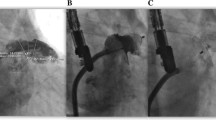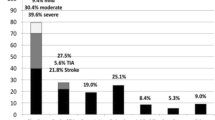Abstract
Background
Transcatheter left atrial appendage (LAA) occlusion has been proven to be an effective treatment for stroke prophylaxis in patients with atrial fibrillation. For this purpose, the Amplatzer cardiac plug (ACP) was introduced. Its second generation, the Amulet, was developed for easier delivery, better coverage, and reduction of complications.
Aim
To investigate the safety and efficacy of first generation versus second generation Amplatzer occluders for LAA occlusion.
Methods
Retrospective analysis of prospectively collected data from the LAA occlusion registries of the Bern and Zurich university hospitals. Comparison of the last consecutive 50 ACP cases versus the first consecutive 50 Amulet cases in patients with non-valvular atrial fibrillation. For safety, a periprocedural combined endpoint, which is composed of death, stroke, cardiac tamponade, and bailout by surgery was predefined. For efficacy, the endpoint was procedural success.
Results
There were no differences between the two groups in baseline characteristics. The percentage of associated interventions during LAA occlusion was high in (78 % with ACP vs. 70 % with Amulet p = ns). Procedural success was similar in both groups (98 vs. 94 %, p = 0.61). The combined safety endpoint for severe adverse events was reached by a similar rate of patients in both groups (6 vs. 8 %, p = 0.7). Overall complication rate was insignificantly higher in the ACP group, which was mainly driven by clinically irrelevant pericardial effusions (24 vs. 14 %, p = 0.31). Death, stroke, or tamponade were similar between the groups (0 vs. 2 %, 0 vs. 0 %, or 6 vs. 6 %, p = ns).
Conclusion
Transcatheter LAA occlusion for stroke prophylaxis in patients with atrial fibrillation can be performed with similarly high success rates with first and second generations of Amplatzer occluders. According to this early experience, the Amulet has failed to improve results of LAA occlusion. The risk for major procedural adverse events is acceptable but has to be taken into account when selecting patients for LAA occlusion, a preventive procedure.

Similar content being viewed by others
Abbreviations
- ACP:
-
Amplatzer cardiac plug
- AF:
-
Atrial fibrillation
- ASA:
-
Acetylsalicylic acid
- ASD:
-
Atrial septal defect
- DAPT:
-
Dual antiplatelet therapy
- GI:
-
Gastrointestinal
- INR:
-
International normalized ratio
- LAA:
-
Left atrial appendage
- LAAO:
-
Left atrial appendage occlusion
- MI:
-
Myocardial infarction
- NOAC:
-
New anticoagulant drug
- OAC:
-
Oral anticoagulation
- PAD:
-
Peripheral artery disease
- PCI:
-
Percutaneous coronary intervention
- PFO:
-
Patent foramen ovale
- TAVI:
-
Transcatheter aortic valve implantation
- TIA:
-
Transient ischemic attack
- VARC:
-
Valve Academic Research Consortium
References
Holmes DR, Reddy VY, Turi ZG, Doshi SK, Sievert H, Buchbinder M, Mullin CM, Sick P (2009) PROTECT AF Investigators. Percutaneous closure of the left atrial appendage versus warfarin therapy for prevention of stroke in patients with atrial fibrillation: a randomised non-inferiority trial. Lancet 374:534–542
Reddy VY, Doshi SK, Sievert H, Buchbinder M, Neuzil P, Huber K, Halperin JL, Holmes D (2013) PROTECT AF Investigators. Percutaneous left atrial appendage closure for stroke prophylaxis in patients with atrial fibrillation: 2.3-Year Follow-up of the PROTECT AF (watchman left atrial appendage system for embolic protection in patients with atrial fibrillation) Trial. Circulation 127:720–729
Landmesser U, Holmes DR (2012) Left atrial appendage closure: a percutaneous transcatheter approach for stroke prevention in atrial fibrillation. Eur Heart J 33:698–704
Holmes DR, Kar S, Price MJ, Whisenant B, Sievert H, Doshi SK, Huber K, Reddy VY (2014) Prospective randomized evaluation of the watchman left atrial appendage closure device in patients with atrial fibrillation versus long-term warfarin therapy. J Am Coll Cardiol 64:1–12
Reddy VY, Sievert H, Halperin J, Doshi SK, Buchbinder M, Neuzil P, Huber K, Whisenant B, Kar S, Swarup V, Gordon N, Holmes D (2014) PROTECT AF Steering Committee and Investigators. Percutaneous left atrial appendage closure vs warfarin for atrial fibrillation: a randomized clinical trial. JAMA 312:1988–1998
Meier B, Blaauw Y, Khattab AA, Lewalter T, Sievert H, Tondo C, Glikson M (2014) EHRA/EAPCI expert consensus statement on catheter-based left atrial appendage occlusion. Europace 16:1397–1416
Bernhardt P, Schmidt H, Sommer T, Lüderitz B, Omran H (2006) Atrial fibrillation—patients at high risk for cerebral embolism. Clin Res Cardiol. 95:148–153
Nührich JM, Kuck K, Andresen D, Steven D, Spitzer SG, Hoffmann E, Schumacher B, Eckardt L, Brachmann J, Lewalter T, Hochadel M, Senges J, Willems S, Hoffmann BA (2014) Oral anticoagulation is frequently discontinued after ablation of paroxysmal atrial fibrillation despite previous stroke: data from the German Ablation Registry. Clin Res Cardiol. doi:10.1007/s00392-014-0804-1
Nielsen PB, Lane DA, Rasmussen LH, Lip GY, Larsen TB (2014) Renal function and non-vitamin K oral anticoagulants in comparison with warfarin on safety and efficacy outcomes in atrial fibrillation patients: a systemic review and meta-regression analysis. Clin Res Cardiol. doi:10.1007/s00392-014-0797-9
Sabouret P, Depret-Bixio L, Cotte FE, Marie P, Bedira N, Blin P (2014) Sex differences in stroke prevention in atrial fibrillation in French primary care. Results of the AFIGP (atrial fibrillation in general practice) database. Clin Res Cardiol. 103:887–893
Meinertz T, Kirch W, Rosin L, Pittrow D, Willich SN, Kirchhof P (2011) ATRIUM investigators. Management of atrial fibrillation by primary care physicians in Germany: baseline results of the ATRIUM registry. Clin Res Cardiol. 100:897–905
Seivani Y, Abdel-Wahab M, Geist V, Richardt G, Sulimov DS, El-Mawardy M, Toelg R, Akin I (2013) Long-term safety and efficacy of dual therapy with oral anticoagulation and clopidogrel in patients with atrial fibrillation treated with drug-eluting stents. Clin Res Cardiol. 102:799–806
Steiner T, Böhm M, Dichgans M, Diener HC, Ell C, Endres M, Epple C, Grond M, Laufs U, Nickenig G, Riess H, Röther J, Schellinger PD, Spannagl M, Veltkamp R (2013) Recommendations for the emergency management of complications associated with the new direct oral anticoagulants (DOACs), apixaban, dabigatran and rivaroxaban. Clin Res Cardiol. 102:399–412
Ewen S, Rettig-Ewen V, Mahfoud F, Böhm M, Laufs U (2014) Drug adherence in patients taking oral anticoagulation therapy. Clin Res Cardiol. 103:173–182
Skeppholm M, Friberg L (2014) Adherence to warfarin treatment among patients with atrial fibrillation. Clin Res Cardiol. 103:998–1005
De Backer O, Arnous S, Ihlemann N, Vejlstrup N, JÃrgensen E, Pehrson S, Krieger TD, Meier P, Søndergaard L, Franzen OW (2014) Percutaneous left atrial appendage occlusion for stroke prevention in atrial fibrillation: an update. Open Heart 1:e000020
Windecker S, Kolh P, Alfonso F, Collet JP, Cremer J, Falk V, Filippatos G, Hamm C, Head SJ, Jüni P, Kappetein AP, Kastrati A, Knuuti J, Landmesser U, Laufer G, Neumann FJ, Richter DJ, Schauerte P, Sousa Uva M, Stefanini GG, Taggart DP, Torracca L, Valgimigli M, Wijns W, Witkowski A, Authors/Task Force members (2014) ESC/EACTS Guidelines on myocardial revascularization: the Task Force on Myocardial Revascularization of the European Society of Cardiology (ESC) and the European Association for Cardio-Thoracic Surgery (EACTS). Developed with the special contribution of the European Association of Percutaneous Cardiovascular Interventions (EAPCI). Eur Heart J 35:2541–2619
Meier B, Palacios I, Windecker S, Rotter M, Cao QL, Keane D, Ruiz CE, Hijazi ZM (2003) Transcatheter left atrial appendage occlusion with Amplatzer devices to obviate anticoagulation in patients with atrial fibrillation. Catheter Cardiovasc Interv 60:417–422
Nietlispach F, Gloekler S, Khattab A, Pilgrim T, Schmid M, Wenaweser P, Windecker S, Meier B (2012) Percutaneous left atrial appendage closure. Eur Geriatr Med. 3:308–311
Nietlispach F, Gloekler S, Krause R, Shakir S, Schmid M, Khattab AA, Wenaweser P, Windecker S, Meier B (2013) Amplatzer left atrial appendage occlusion: single center 10-year experience. Catheter Cardiovasc Interv 82:283–289
Schmid M, Gloekler S, Suguner A, Wahl A, Fischer U, Arnold M, Khattab A, Nietlispach F, Guerios E, Wenaweser M, Windecker S, Meier B (2013) Transcatheter left atrial appendage closure in patients with atrial fibrillation. Cardiovasc Med. 16:123–130
Urena M, Rodés-Cabau J, Freixa X, Saw J, Webb JG, Freeman M, Horlick E, Osten M, Chan A, Marquis JF, Champagne J, Ibrahim R (2013) Percutaneous left atrial appendage closure with the AMPLATZER cardiac plug device in patients with nonvalvular atrial fibrillation and contraindications to anticoagulation therapy. J Am Coll Cardiol 62:96–102
Rodés-Cabau J, Champagne J, Bernier M (2010) Transcatheter closure of the left atrial appendage: initial experience with the Amplatzer cardiac plug device. Catheter Cardiovasc Interv 76:186–192
Park JW, Bethencourt A, Sievert H, Santoro G, Meier B, Walsh K, Lopez-Minquez JR, Meerkin D, Valdés M, Ormerod O, Leithäuser B (2011) Left atrial appendage closure with Amplatzer cardiac plug in atrial fibrillation: initial European experience. Catheter Cardiovasc Interv 77:700–706
Freixa X, Chan JL, Tzikas A, Garceau P, Basmadjian A, Ibrahim R (2013) The Amplatzer™ Cardiac Plug 2 for left atrial appendage occlusion: novel features and first-in-man experience. Eurointervention. 8:1094–1098
Freixa X, Abualsaud A, Chan J, Nosair M, Tzikas A, Garceau P, Basmadjian A, Ibrahim R (2014) Left atrial appendage occlusion: initial experience with the Amplatzer™ Amulet™. Int J Cardiol 174:492–496
Gage BF, Waterman AD, Shannon W, Boechler M, Rich MW, Radford MJ (2001) Validation of clinical classification schemes for predicting stroke: results from the National Registry of Atrial Fibrillation. JAMA 285:2864–2870
Lip GY, Nieuwlaat R, Pisters R, Lane DA, Crijns HJ (2010) Refining clinical risk stratification for predicting stroke and thromboembolism in atrial fibrillation using a novel risk factor-based approach: the Euro Heart Survey on atrial fibrillation. Chest 137:263–272
Pisters R, Lane DA, Nieuwlaat R, de Vos CB, Crijns HJ, Lip GY (2010) A novel user-friendly score (HAS-BLED) to assess 1-year risk of major bleeding in patients with atrial fibrillation: the Euro Heart Survey. Chest 138:1093–1100
Wasmer K, Köbe J, Dechering D, Milberg P, Pott C, Vogler J, Stypmann J, Waltenberger J, Mönnig G, Breithardt G, Eckardt L (2013) CHADS(2) and CHA(2)DS (2)-VASc score of patients with atrial fibrillation or flutter and newly detected left atrial thrombus. Clin Res Cardiol. 102:139–144
Meier B (2007) Catheter-based atrial shunt occlusion, when the going gets even tougher: editorial comment to use of a straight, side-hole (SSH), delivery sheath for improved delivery of Amplatzer ASD occluder. Catheter Cardiovasc Interv 69:21–22
Mehran R, Rao SV, Bhatt DL, Gibson CM, Caixeta A, Eikelboom J, Kaul S, Wiviott SD, Menon V, Nikolsky E, Serebruany V, Valgimigli M, Vranckx P, Taggart D, Sabik JF, Cutlip DE, Krucoff MW, Ohman EM, Steg PG, White H (2011) Standardized bleeding definitions for cardiovascular clinical trials: a consensus report from the Bleeding Academic Research Consortium. Circulation 123:2736–2747
Meerkin D, Butnaru A, Dratva D, Bertrand OF, Tzivoni D (2013) Early safety of the Amplatzer Cardiac Plug™ for left atrial appendage occlusion. Int J Cardiol 168(4):3920–3925. doi:10.1016/j.ijcard.2013.06.062
Guérios EE, Schmid M, Gloekler S, Khattab AA, Wenaweser PM, Windecker S, Meier B (2012) Left atrial appendage closure with the Amplatzer cardiac plug in patients with atrial fibrillation. Arq Bras Cardiol 98:528–536
Schroeter MR, Danner BC, Hünlich M, Schillinger W (2014) Uncommon delayed and late complications after percutaneous left atrial appendage closure with Amplatzer(®) Cardiac Plug. Clin Res Cardiol. 103:285–290
Beigel R, Wunderlich NC, Ho SY, Arsanjani R, Siegel RJ (2014) The left atrial appendage: anatomy, function, and noninvasive evaluation. JACC Cardiovasc Imaging. 7:1251–1265
Saw J, Lempereur M (2014) Percutaneous left atrial appendage closure: procedural techniques and outcomes. JACC Cardiovasc Interv. 7:1205–1220
Freixa X, Kwai Chan JL, Tzikas A, Garceau P, Basmadjian A, Ibrahim R (2013) Percutaneous closure of a very large left atrial appendage using the amplatzer amulet. Can J Cardiol 29:1329.e9–1329.e11
Conflict of interest
Ahmed A. Khattab and Fabian Nietlispach are consultants to St. Jude Medical, Stefan Windecker has received grants to the institution from St. Jude Medical, and Bernhard Meier is a consultant to and has received grants to the institution from St. Jude Medical.
Author information
Authors and Affiliations
Corresponding author
Additional information
S. Gloekler and S. Shakir contributed equally to this work.
Rights and permissions
About this article
Cite this article
Gloekler, S., Shakir, S., Doblies, J. et al. Early results of first versus second generation Amplatzer occluders for left atrial appendage closure in patients with atrial fibrillation. Clin Res Cardiol 104, 656–665 (2015). https://doi.org/10.1007/s00392-015-0828-1
Received:
Accepted:
Published:
Issue Date:
DOI: https://doi.org/10.1007/s00392-015-0828-1




